Interview with Chris Osapai from The Necrossia Kickstarter
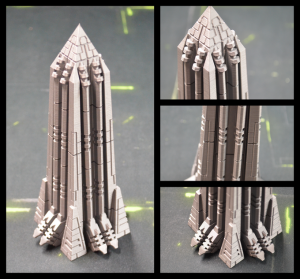 This is the first release from ProtoKraken. Their first offering, is the Necron inspired wargame terrain called Necrossia. Necrossia is also the starting point for their new line of terrain called 3rD Army Terrain. Further in the interview, you will find out what inspired the name and how he came up with this terrific looking Kickstarter. Necrossia has already cracked all but one of their funding stretch goals, and are extremely close to reaching their final social stretch goal as well. This was a pretty good deal to begin with, and adding in all these stretch goals just makes it that much more worthwhile. One of the great parts about this Kickstarter, is that it caters to a very underrepresented terrain need. There is not a lot of Necron inspired terrain out there. This is a great counter point to the dark Gothic sci-fi terrain you see all over on other boards.
This is the first release from ProtoKraken. Their first offering, is the Necron inspired wargame terrain called Necrossia. Necrossia is also the starting point for their new line of terrain called 3rD Army Terrain. Further in the interview, you will find out what inspired the name and how he came up with this terrific looking Kickstarter. Necrossia has already cracked all but one of their funding stretch goals, and are extremely close to reaching their final social stretch goal as well. This was a pretty good deal to begin with, and adding in all these stretch goals just makes it that much more worthwhile. One of the great parts about this Kickstarter, is that it caters to a very underrepresented terrain need. There is not a lot of Necron inspired terrain out there. This is a great counter point to the dark Gothic sci-fi terrain you see all over on other boards.
- What miniatures games/RPGs do you play that inspired this Kickstarter?
- Warhammer 40,000 and Star Wars Legion were the main two, but Age of Sigmar also had an influence in helping to establish the direction of the designs, particularly the Ossiarch Bonereapers. I was already a few weeks into planning and design when the Ossiarch line was announced, and the Bone-Tithe Nexus struck some similar aesthetic notes to what I was trying to capture.
- How long have you owned a 3D Printer and been making miniatures and terrain?
- I’ve only owned a printer for a bit over a year now, but have used printers professionally and for educational purposes for over a decade. As for how long I’ve been designing miniatures and terrain, thats a bit of a tricky question – I first started designing things that I hoped would become miniatures about 15+ years ago, but in those days 3D printing wasn’t really accessible and I was designing them more with an eye towards getting masters printed so that I could get the minis resin cast, or maybe using CAM processes to get injection molds cut – mind you I had zero money with which I might have been able to make this happen, but it was nice to dream.
- What printers do you use to print terrain and miniatures?
- Currently I do everything on a Prusa i3 Mk3, I hope to upgrade to upgrade to a resin printer down the line though.
- What got you interested in modeling 3D miniatures for print? What was your first model?
- Oh man, I don’t even know anymore. I was exposed to 3D modeling for the first time in high school, right when I was getting into tabletop wargaming and miniatures gaming, so it probably wasn’t a leap for me to get from point a to point b on that one. I think my first 3D model (for personal purposes as opposed to ones I had to do for a school assignment) was my take on a Mobile Suit, but there was also this giant land-battleship of a tank I was working on at the time, I’m not sure which one came first or if I ever finished either one of them, but I’m not sure if I ever really intended for those to be anything other than a 3D art project. The first model I ever really designed with the intent of producing a physical miniature, but not necessarily 3D printed, was another tank design which I created a project blog for on several popular 40k forums back in the day, you might be able to still find those photos online if you look, maybe one day I’ll revisit that concept. The first model I ever designed specifically for 3D printing however, was yet another tank design – which I still haven’t finished working on. The first *completed* model I ever designed, however, would be the Cenotaph terrain piece in this Kickstarter campaign.
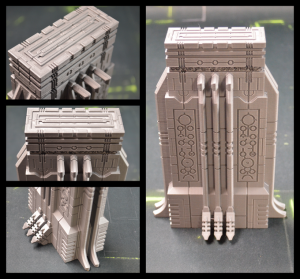 Do you have a favorite model you have created?
Do you have a favorite model you have created?
- In terms of completed designs, probably the Cenotaph – I totally adore the sculpt and am extremely proud of it, but I think my most recent unfinished tank design is probably my favorite overall.
- How did you come up with the idea for 3rD Army and Necrossia?
- Well, for the longest time – we’re talking about going back *years* – I’ve generally just been annoyed at the state of terrain in the tabletop wargaming community. It’s long been an overlooked part of the hobby, and you end up with people with these gorgeously painted armies (if you’re lucky, anyway) duking it out between red solo cups and foam packing materials repainted to look like a concrete bunker or something (or just felt cutouts with the word “forest” written on them) because nobody ever wants to invest the time, money, or resources into collecting a decent tables worth of terrain. I think a lot of players have an attitude that terrain is somebody elses problem to deal with – its either your stores responsibility or your clubs responsibility, but never your responsibility or your opponents. Things have become a lot better in that regard as various companies have started making affordable terrain kits for people to buy and collect, as well as a number of pre-painted options now being on the market, etc. but 3D printing seems destined to become the primary resource for wargaming terrain as a function of cost and also the amazingly huge range of options that the 3D printing community has developed.But that still isn’t enough for me, because I’ve also been long frustrated by the way a lot of this terrain is being designed, used, and thought of. If you’ve ever visited a historic battlefield, or maybe just kinda imagined what it would be like to fight a war in your neighborhood (other people do that, right? I’m not the only one?), you quickly realize that real battlefields are far from being flat. Elevation and topography play a huge part in real-world warfare, and geographic features and major landmarks often become focal points for combat. As gamers we have a tendency to view terrain pieces as being these discrete features that we are placing on top of our favorite gaming mat or textured/flocked mdf board or what-have-you – our battlefields are basically flat, we may have some localized elevation as a result of a building or something, but its generally rare to see tables where elevation and topography seriously factor into the gameplay. Our buildings, relative to the size of our infantry, are rarely large enough to even be considered a suburban middle-class home, our forests are 3 trees that are barely taller than person, our rivers would barely qualify as a run-off stream. I recognize that there are many reasons for this, due to affordability, portability, and playability, but I’m still disappointed by it. When I first started getting into the wargaming hobby I had these wild dreams of being an armchair general fighting battles over these amazing battlefields featuring massive cathedral-sized buildings and rolling hills and deep valleys and just all these dramatic features – especially when it comes to science fiction gaming where cities and structures, and the battles fought over and in them, are often on an incomprehensibly vast scale. I have yet to ever play a game on anything even remotely approaching that.So I told myself I was going to design some terrain – terrain that could be used to build complex battlefields where elevation wasn’t just an afterthought but a feature intrinsic to the battlefield, but which still took considerations of playability and mechanical interaction with the various game rulesets out there into account, and which could easily be deconstructed and stashed away for storage or transportation to and from your favorite gaming venue. So I started working on some stuff, and then I scope-creeped myself out of having any hope of finishing it in a realistic timeframe, so I started another project, and the same thing happened, and finally I told myself I needed to do something relatively simple – something that I could finish in a reasonable timeframe and put out into the world just to get myself out there and see if there was anyone else that was looking for the same things from their gaming that I am. A friend suggested Necron terrain, i looked around, saw some stuff out there but nothing that really appealed to me aesthetically, so I told myself I was going to give a go at redefining the aesthetic, and Necrossia happened.The name “3rD Army Terrain” kind of came naturally from that, as I think what I’m trying to do really ties into the idea of terrain as the 3rD army on the tabletop (or battlefield, depending on who you’re talking to). I don’t know where or when I first heard that concept but its stuck with me for a long time, and I think it fit personally. Plus, with the odd capitalization scheme of “3rD” it also functioned as an effective allusion to “3D”, which plays into both how this stuff is made and also emphasizes the idea of it being truly “three-dimensional”, in the sense of creating variable elevation.
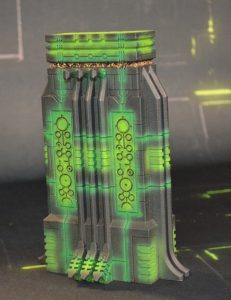 How long have you been working on Necrossia? What about 3rD Army Terrain? Was this planned as the first release, or did you come up with others as well?
How long have you been working on Necrossia? What about 3rD Army Terrain? Was this planned as the first release, or did you come up with others as well?
- I started working on Necrossia around August or September of 2019, and I finished most of the work on the base pledge, at least in terms of getting it “launch ready” at the end of December. It took me about another month to crank out a bunch of test prints, make some adjustments, paint up a sample, photograph it, make a video, and write up a campaign page before I was able to launch. As for 3rD Army Terrain as a whole, I think I really started grinding out terrain designs in late 2018 or early 2019, its hard for me to put a date to it, but its been a long time coming. Necrossia definitely wasn’t planned as the first release, it isn’t even remotely close to the first project I started working on for future sale. After a few stalled vehicle-based projects I decided to try my hand at terrain, thinking it would be quicker and simpler – Necrossia was probably my 3rd or 4th attempt at that before I finally got it right. Thats not to say the other projects have failed, its just that scope-creep is my worst enemy and since everything I’ve started on has some degree of modularity to it, I could design parts and pieces for these things literally forever and never get it to a point where I think I’m “finished” and ready for release. Necrossia was the project where I told myself from the beginning I would do something much more scope-limited, no matter where my ideas took me I was going to keep it narrowly defined to just a “minimum viable product” just to get it out there, just so I could say I did it, and anything beyond that scope would be pushed to a future project or product, so I could take some lessons learned from Necrossia and apply it back to those other projects and get them turned around and out the door.
- You are starting a new line with the 3rD Army Terrain. Where do you think you will go next?
- Oh, I’ve got big, big plans. Of course, once this kickstarter campaign ends I’ve got to make sure I get the base pledge files out the door to backers and I’m going to try to crank through all those stretch goals as quickly as possible, but after that its back to the project I started immediately prior to Necrossia. I don’t want to give too much away, but it’s something I’ve seen people clamoring for for some time – oddly enough I’ve even noticed some of my current backers mention it during the course of the campaign on various facebook groups as something they are hoping to see someone do in the future, which brought me a bit of a smile, made me feel like I’m on the right path with things. When that project launches there will also be a free Necrossia upgrade for returning backers, as that other project ties into something I wanted to do with Necrossia but had to put on the backburner as it was outside of that narrowly defined scope I set for this kickstarter campaign – I think its something people are going to really enjoy, as far as Necrossia is concerned, and I’m giving it away because I believe in rewarding repeat customers with a little something extra.
- What is your workflow for creating pieces for Necrossia?
- That’s a hard question to answer, as there really wasn’t one. My other projects were something that I planned out a bit, I did concept sketches, I translated those sketches to 3D models, making minor adjustments to it. With Necrossia, I kind of just jumped straight into it. Part of the interesting thing with Necrossia was that while I had a strong idea of what I wanted Necrossia to be, I didn’t have any idea what it would actually look like when it was done. I had a couple of loosely defined aesthetic concepts that I wanted to incorporate into the designs, but for the most part I skipped sketching things out entirely (and what I did sketch I basically didn’t use – which was a good thing because those sketches ended up forming the foundation for the stretch goals) and I just started modeling and trying different things and iterating and adjusting things and revisiting and reworking things. It was a very organic and fluid process where I basically designed everything as I went. To give you an idea of how that ended up working out for me, the Monolith was the first piece that I started working on for this project, and it was one of the last ones to actually be finished. Just about every piece went through some pretty significant changes and design evolution as I went about doing things. I would start on a piece, say to myself “okay I think this is done”, move on to something else, try something new, and say “damn, that looks good, I want to use this for something else” and go back and rework a part of that other model to incorporate that new design element. This isn’t really the way I prefer to work, and it definitely slowed down the design process drastically as I was constantly reworking and modifying things right up until the end, but I can’t deny that it worked out in the end. If nothing else, I think it helped keep things interesting for me, as I did get somewhat burned out on some of the other projects I started, simply because designing some of the parts for those projects became this almost robotic process of just copying my 2D drawings into a 3D space – there wasn’t any fun or excitement in it, and it felt more like work than a hobby or something that I was doing because I enjoyed it.
- What software do you use for your modeling?
- Primarily Fusion360, but I also use Blender for some things, though I’m not as familiar with it. In the past I’ve also used Pro/Desktop, Pro/Engineer, Creo, Solidworks, Siemens NX/Unigraphics, Rhino3D and ZBrush – I’m hoping to buy a license for ZBrush soon, as I absolutely love that software and what I can do with it.
- I know you added magnets after the KS had started. What made you go with that idea? (It looks very simple to build with the addition of magnets)
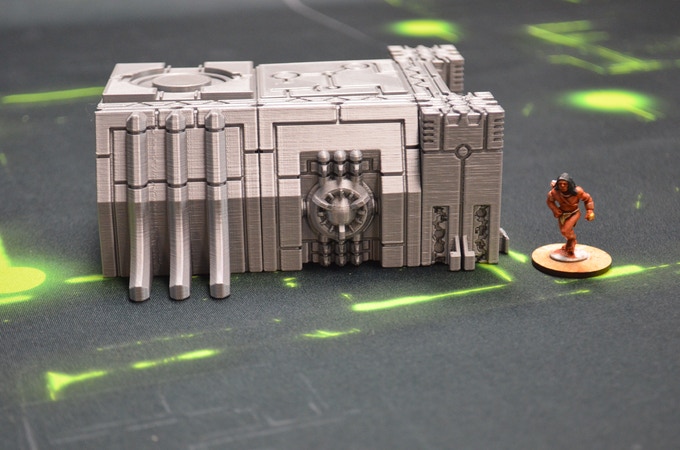 It was something I wanted from the beginning, but had to rule out as the original design of the Necropolis system was a bit more complex and less intuitive to assemble. The problem I came across then was that in many cases you would want to reverse the placement of the various pieces if you were trying to change up your layout, but the magnets would then have the reverse polarity (well, really matching polarity, but you get the point) and wouldn’t connect to each other, so I resigned myself to having to make do with the mechanical clip system that was part of the system on launch day in order to keep it as flexible as possible. I moved away from that initial design concept pretty quickly, but the idea of “I can’t use magnets with this because they won’t align correctly in every case, so I have to use clips instead” really stuck with me all the way up until at least a few days after the kickstarter campaign launched. At that point I was having a conversation with a friend of mine at the local shop who was congratulating me on the campaign and asking me questions about it (I’m fairly secretive about my personal projects so it came as a bit of a surprise to many of my friends, even many of those who knew I was working on a kickstarter project had no idea what it actually was or looked like). While explaining to them how the Necropolis pieces fit together I suddenly realized that the “reversibility” situation was almost entirely a non-factor with the system I had ended up developing and launching with (to some extent it still remained with the “universal corner pieces” but I didn’t feel like that was enough to justify *not* magnetizing the rest of it). I made a mental note to look into it the next time I was in front of my computer and able to spend some time modeling and printing. A day or two later I quickly modeled up a couple of wall sections with what I figured would be the necessary modifications, printed them out glued some magnets in, realized that I glued them in the wrong direction and tossed the pieces out, printed up new wall pieces, glued the magnets in the right way, and plugged them together and it worked. The amount of time it took me to modify the wall section to accommodate the magnets couldn’t have been more than a minute, probably only 45 seconds at most, and I could speed that up a bit by copy/pasting the two-dimensional sketch from file to file, so I decided to commit to the change and posted an update about it.
It was something I wanted from the beginning, but had to rule out as the original design of the Necropolis system was a bit more complex and less intuitive to assemble. The problem I came across then was that in many cases you would want to reverse the placement of the various pieces if you were trying to change up your layout, but the magnets would then have the reverse polarity (well, really matching polarity, but you get the point) and wouldn’t connect to each other, so I resigned myself to having to make do with the mechanical clip system that was part of the system on launch day in order to keep it as flexible as possible. I moved away from that initial design concept pretty quickly, but the idea of “I can’t use magnets with this because they won’t align correctly in every case, so I have to use clips instead” really stuck with me all the way up until at least a few days after the kickstarter campaign launched. At that point I was having a conversation with a friend of mine at the local shop who was congratulating me on the campaign and asking me questions about it (I’m fairly secretive about my personal projects so it came as a bit of a surprise to many of my friends, even many of those who knew I was working on a kickstarter project had no idea what it actually was or looked like). While explaining to them how the Necropolis pieces fit together I suddenly realized that the “reversibility” situation was almost entirely a non-factor with the system I had ended up developing and launching with (to some extent it still remained with the “universal corner pieces” but I didn’t feel like that was enough to justify *not* magnetizing the rest of it). I made a mental note to look into it the next time I was in front of my computer and able to spend some time modeling and printing. A day or two later I quickly modeled up a couple of wall sections with what I figured would be the necessary modifications, printed them out glued some magnets in, realized that I glued them in the wrong direction and tossed the pieces out, printed up new wall pieces, glued the magnets in the right way, and plugged them together and it worked. The amount of time it took me to modify the wall section to accommodate the magnets couldn’t have been more than a minute, probably only 45 seconds at most, and I could speed that up a bit by copy/pasting the two-dimensional sketch from file to file, so I decided to commit to the change and posted an update about it.
Thank you to Chris for taking some time out of his extremely busy schedule to answer these questions. Necrossia is a terrific looking Kickstarter for any sci-fi battlefield, but especially nice looking for the Necron players out there. Plus, for those that get tired of all their worlds looking like they are Gothic cathedrals all owned by man kind, and there is not any Xenos civilizations to fight over.
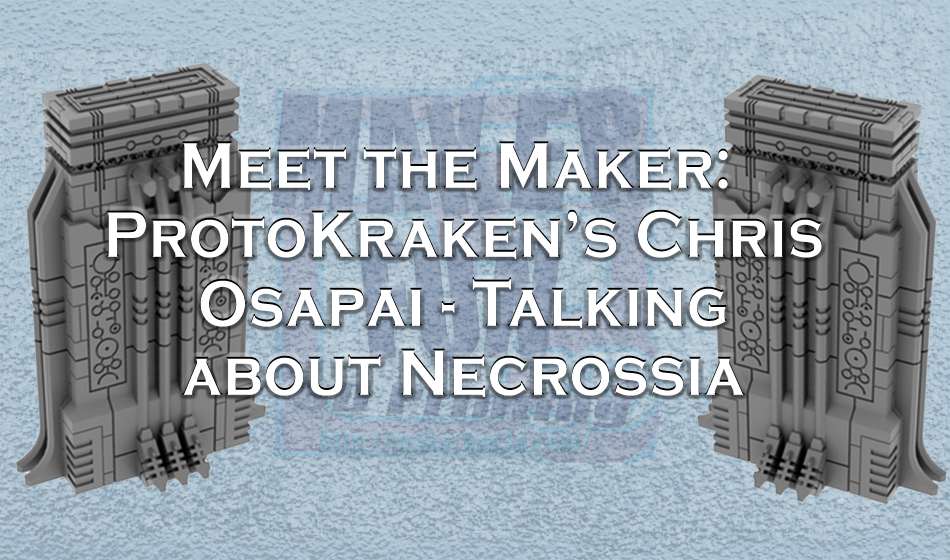
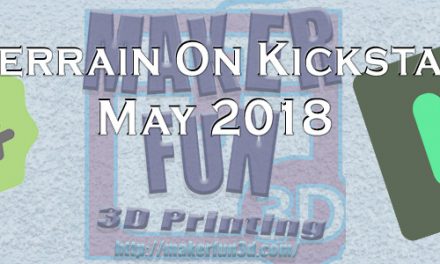

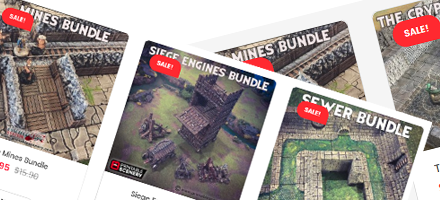
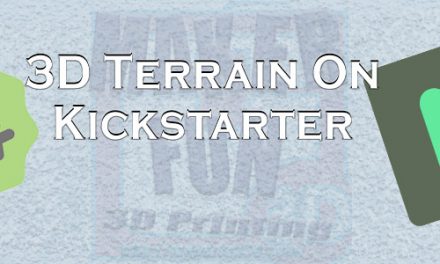
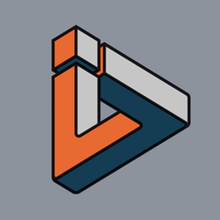
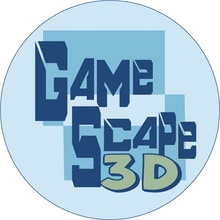
Trackbacks/Pingbacks